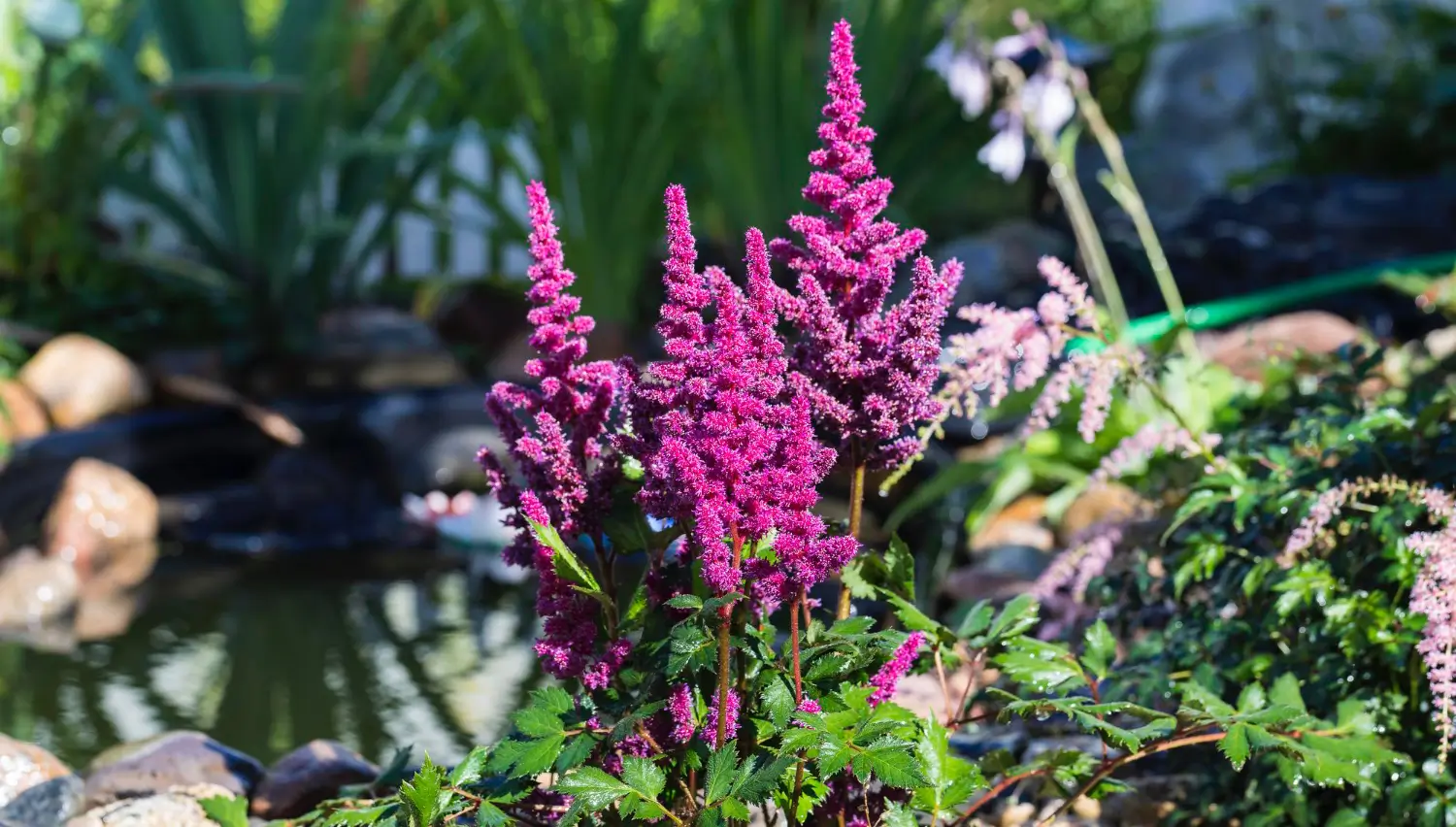
August 24, 2025

A shade garden can be a calm and beautiful place. In the morning, soft light shines through the trees, and the green plants create a peaceful feeling. These gardens are special because they allow plants to grow without direct sunlight. But it can be hard to find plants that grow well in low light and still look pretty.
In these shady spots, Astilbe is a plant that helps nature, makes outdoor spaces look better, and gives people a sense of peace. Its soft, feathery flowers come in pink, purple, and white, adding bright colors to the garden. It grows well along garden edges, in woodland areas, and near ponds. It is also easy to take care of and grows in different conditions.
Growcycle offers various gardening products and supplies, such as grow lights, soil nutrients, and irrigation systems, which can create optimal growing conditions for Astilbe and other perennials.
Astilbe is an herbaceous perennial plant native to Asia and North America. It is known for its feathery, plume-like flowers and lush, fern-like foliage. The plant belongs to the Saxifragaceae family and thrives in woodland environments with moist, well-drained soil.
Astilbe is known for its delicate, feathery flowers and lush foliage. It is a favorite among gardeners looking to add color, texture, and movement to shaded areas.
Astilbe is best known for its soft, feathery flower plumes, which grow on tall, slender stems above its foliage. These flowers give the plant an airy, elegant look that enhances any shaded garden. Depending on the variety, the blooms can be white, pink, red, lavender, or purple.
Some cultivars, like ‘Fanal,’ have deep red blooms, while others, such as ‘Bridal Veil,’ feature bright white flowers. The size of the flower spikes varies as well, ranging from 6 inches to 2 feet (15 cm to 60 cm) in length, depending on the species. Astilbe typically blooms in late spring to midsummer, and its flowers last for several weeks.
Even after the blooming period, the dried flower plumes retain their shape and structure, adding visual interest to the garden well into the fall and winter. These flowers also attract pollinators like bees and butterflies, making them a beneficial addition to wildlife-friendly landscapes.
Astilbe’s fern-like foliage is another key feature that makes it a standout in gardens. The leaves are deep green, bronze-green, or reddish-green. Some species, like Astilbe japonica, have glossy, finely serrated leaves that provide extra texture to the garden.
Astilbe has many varieties, each offering unique flower colors, sizes, and growth habits. Here are some of the most popular types, categorized based on their species and hybrid groups:
| Species | Growth Habit | Flower Characteristics | Notable Varieties |
|---|---|---|---|
| Chinese Astilbe | Compact, more drought-tolerant than other Astilbes. | Small, dense, upright plumes in pink, purple, and lavender shades. | Vision in Pink, Vision in Red, Pumila |
| Arendsii Hybrids | Tall and bushy, one of the most common hybrid groups. | Large, feathery plumes in white, pink, red, and purple. | Fanal, Bridal Veil, Deutschland |
| Japanese Astilbe | Medium-sized with early blooming flowers. | Dense, pyramidal plumes in white, pink, or red. | Montgomery, Peach Blossom, Red Sentinel |
| Dwarf Astilbe | Smaller, delicate, with simple leaves. | Light, airy plumes in pink and white. | Sprite, Hennie Graafland |
| Thunberg’s Astilbe | Taller, with arching flower plumes. | Light, airy, cascading blooms. | Ostrich Plume |
Astilbe is one of the best perennials for shade gardens, offering a combination of beauty, adaptability, and low maintenance. It thrives in low-light conditions where many other flowering plants struggle. Here are some of its benefits:
Astilbe cany to brighten up dim, shady spots with its feathery, plume-like flowers. Unlike many shade-loving plants that offer only foliage, it brings a splash of white, pink, red, purple, or lavender blooms to garden spaces that receive little direct sunlight.
These tall, airy flowers rise above their lush, fern-like foliage, creating an elegant, eye-catching display. Even after the blooms fade, the dried flower heads provide structure and beauty through the fall and winter, ensuring that the garden remains visually appealing across multiple seasons.
Astilbe is also known for its high tolerance to low-light conditions, making it ideal for gardens with limited sunlight. Unlike many other perennials that struggle in the shade, Astilbe survives and thrives in partial to full shade. It is well-suited for woodland gardens, under tree canopies, along shaded borders, or in areas with dappled sunlight.
Additionally, it grows well in moist, well-drained soils and easily adapts to different garden conditions. While it prefers rich, organic soil, it can still perform well in average soil if kept consistently moist.
Gardeners of all experience levels appreciate Astilbe for its low-maintenance nature. Once established, it requires minimal care, with no need for frequent pruning or deadheading. It is resistant to pests and diseases, reducing the need for chemical treatments. With proper watering and occasional fertilization, Astilbe continues to grow vigorously year after year, requiring little effort from the gardener.
Astilbe also plays an important role in the garden ecosystem. Its nectar-rich flowers attract pollinators like bees and butterflies, supporting local biodiversity. Additionally, the plant provides seasonal interest, as its foliage appears fresh in spring, flowers in summer, and often takes on golden or reddish hues in the fall. Even in winter, the dried flower spikes add visual interest to the landscape.
Proper preparation is key to ensuring that Astilbe thrives in the garden. This includes selecting the right site, preparing the soil, and managing moisture levels to support healthy growth.
Astilbe flourishes in shady or part-shaded locations, making it an excellent choice for gardens with limited direct sunlight. Ideally, it should be planted in an area with dappled light or morning sun and afternoon shade. Too much direct sunlight can scorch the leaves and reduce bloom longevity, while deep shade may result in fewer flowers.
Consider the microclimates in the garden, such as areas near buildings, fences, or large trees, where shade levels may vary throughout the day. Locations with consistent moisture and protection from strong winds will help the plant grow strong and healthy. Astilbe also works well along woodland edges, beside ponds or streams, or under taller shrubs and trees, where it receives enough filtered light while benefiting from naturally moist soil conditions.
Astilbe prefers rich, organic, and well-draining soil that retains moisture without becoming waterlogged. It thrives in slightly acidic to neutral soil (pH 5.5–7.0). Before planting, test your soil’s pH and structure. If the soil is too sandy or heavy with clay, amendments can improve its quality.
To prepare the soil, loosen it to a depth of 12 to 15 inches (30 to 38 cm) and mix in organic matter such as compost, aged manure, or peat moss. This improves both nutrient content and moisture retention. If the soil is too dense or compacted, adding perlite or coarse sand helps improve drainage. A layer of mulch after planting also contributes to soil health by keeping moisture levels steady.
Astilbe requires consistent moisture, as dry soil can lead to stunted growth and fewer blooms. However, standing water can cause root rot, so finding the right balance is crucial.
Once the garden is prepared, proper planting and early care will ensure that Astilbe establishes strong roots and thrives in its new environment.
Proper spacing ensures good air circulation, reducing the risk of disease while allowing each plant to reach its full potential. The recommended distance between plants depends on the variety:
The best time to plant Astilbe is in early spring or fall when temperatures are cooler and soil moisture levels are stable. Spring planting allows Astilbe to establish its roots before the summer heat arrives, while fall planting gives the roots time to develop before winter dormancy. Here is the step by step guide to planting Astilbe:
Astilbe is a relatively low-maintenance plant, but proper care throughout the year ensures healthy growth, vibrant blooms, and long-lasting beauty in the garden.
Astilbe benefits from regular feeding to promote lush foliage and abundant flowers. Recommended fertilization schedule:
Avoid over-fertilizing, as excessive nitrogen can promote leaf growth at the expense of flowers.
Pruning is minimal with Astilbe, but removing spent blooms and managing foliage can enhance the plant’s appearance and health.
Over time, astilbe forms dense clumps, which can lead to overcrowding and reduced flowering. Dividing helps rejuvenate plants and expand the garden. This plant should be divided during early spring or fall, when temperatures are mild, to minimize stress on the plant. Dividing the plant every 3–4 years helps maintain its vigor, preventing overcrowding and ensuring continued healthy growth.
Astilbe is generally resistant to most pests and diseases, but a few common issues can still affect its health. Proper care and preventive measures help keep the plant thriving.
Where does Astilbe grow best?
Astilbe thrives in part-shade to full shade with moist, well-draining soil rich in organic matter.
What is the season for Astilbe?
Astilbe blooms in late spring to mid-summer, depending on the variety.
Which flower means beauty?
The Astilbe flower symbolizes beauty, patience, and dedication, making it a perfect choice for elegant garden displays.
Astilbe is a great plant for shade gardens because it is beautiful, easy to grow, and does not need much care. Its soft, feathery flowers and green leaves make any garden look bright, even in low light. It grows well along garden paths, in wooded areas, and near ponds. Astilbe also attracts pollinators like bees and butterflies, adding life to the garden. Explore Growcycle to learn more about Astilbe healthy growth in the garden.
Disclaimer: This material is for informational purposes only and should not be relied on for legal, medical, financial, or any other form of professional advice.